Shopify vs Lightspeed: Which Comes as the Optimal Solution?

Between Shopify vs Lightspeed, which will be the winner? Short answer: it depends. There is no such thing as a better platform, only the platform that suits you most.
But don’t worry! In this article, we will analyze the two platforms under 8 key factors and let you decide which comes as the optimal solution for your demand and budget.
1. Shopify vs Lightspeed: A Quick Glance
1.1. An Overview of Shopify vs Lightspeed
 |  | |
| Definition | An eCommerce platform packed with robust eCommerce, sales, and marketing features. | A leading POS system that comes with essential eCommerce features. |
| Rating | Generally, it has high ratings for its ease of use, and extensive features. | Often praised for its robust POS system and detailed inventory management. |
| Popularity | Over 4,5 million live websites are powered by Shopify. | Over 9,700 companies use Lightspeed, large those in the retail industry. |
| Best used for | Best for businesses focusing on online sales. | Ideal for businesses with a strong physical retail presence. |
| POS software pricing ❗ The prices listed here are for the US and should only be used for reference. | Shopify has 3 main pricing plans, which allow you to operate a feature-rich online store. They all include POS Lite for free: 1. Basic: $39 2. Shopify: $105 3. Advanced: $399 You can choose to only use its POS system at the following prices: 1. POS Lite: $5 with limited online store 2. POS Pro: $89/location with a limited online store Each extra location will cost you $89 for POS Pro. | Lightspeed offers you three main pricing plans: 1. Lean: $89 (❌ eCommerce features, accounting, loyalty) 2. Standard: $149 (❌ loyalty) 3. Advanced: $269 |
| Ease of use | Known for its user-friendly interface and straightforward setup. | User-friendly but with a steeper learning curve due to advanced POS features. |
| Support | 24/7 support via email, chat, and phone. | Offers extensive support, but availability may vary by plan. |
| Key features | Strong in eCommerce integration, shipping, and online marketing. | Robust inventory, employee, and customer management features. |
| Location management | Shopify allows you to add POS Pro for each additional location, allowing you to sync and manage inventory easily. But the customization for each location isn’t as extensive as Lightspeed. | Lightspeed is more suitable for businesses with complex multi-location setups and intricate inventory requirements. |
| Inventory management | Strong inventory management suited for eCommerce. | Advanced inventory management, great for complex retail setups. |
| Customer management | Shopify allows detailed customer profiles with purchase history, contact info, and integration with email marketing platforms. | Lightspeed surpasses Shopify in customer management with built-in loyalty features and detailed analytics. |
| Payment processing | Shopify has better online payment processing features with Shopify Payments and 100+ third-party payment gateways. | Lightspeed has more specialized system for offline transactions– something that is yet to be possible with Shopify. |
| Integration | Lightspeed has a more specialized system for offline transactions– something that is yet to be possible with Shopify. | Lightspeed App Store for online store needs are only around 100 apps. This number cannot even come close to that of Shopify. |
| Report & analytics | Shopify offers comprehensive analytics on sales, customers, inventory, security, etc. but analytics for POS isn’t as in-depth as Lightspeed. | Lightspeed gives you all the analytics you need to make more informed decisions for your physical store. |
| Mobile POS app | Shopify gives you a mobile POS app to manage your store on the go. | Lightspeed also offers a mobile POS app. But their app is superior because it is personalized to your store niche (retail, restaurants, etc.) |
| POS hardware | Lightspeed has a more specialized system for offline transactions– something that is yet to be possible with Shopify. | Lightspeed offers more durable, customizable hardware that can handle higher volumes or specialized tasks. |
1.2. The key difference between Shopify vs Lightspeed
Both platforms allow you to launch and manage your business effectively. However, if your main focus is selling online, we highly advise you to choose Shopify.
But if you have a large, growing brick-and-mortar store, we don’t think you could find any better option than Lightspeed.
But how so? Well, let’s discover more with a detailed comparison between Shopify vs Lightspeed below!
2. Shopify vs Lightspeed: an honest, head-to-head comparison
2.1. POS software pricing
You won’t want to break the bank, so first, let’s dig into Shopify POS vs Lightspeed in terms of pricing.
| ❗ Important: Shopify and Lightspeed both offer varied prices based on different countries and the pricing information we use below is for the US only. Therefore, you should use it for reference only. |
2.1.1. Shopify
Shopify offers three main pricing plans for operating an online store, all of which include POS Lite for free:
- Basic Shopify: $39/month, suitable for small businesses just starting out.
- Shopify Plan: $105/month, offering more features for growing businesses.
- Advanced Shopify: $399/month, ideal for larger businesses needing advanced features.
- Shopify Plus: Starting from $2000/month, suitable for enterprises with advanced and custom requests.
Additionally, Shopify provides options focused solely on POS:
- POS Lite: $5/month, offering basic POS functionalities with limited online store features.
- POS Pro: $89/month per location; it includes more advanced POS features and limited online store capabilities.
For businesses operating in multiple locations, each additional location would incur a cost of $89 per month.
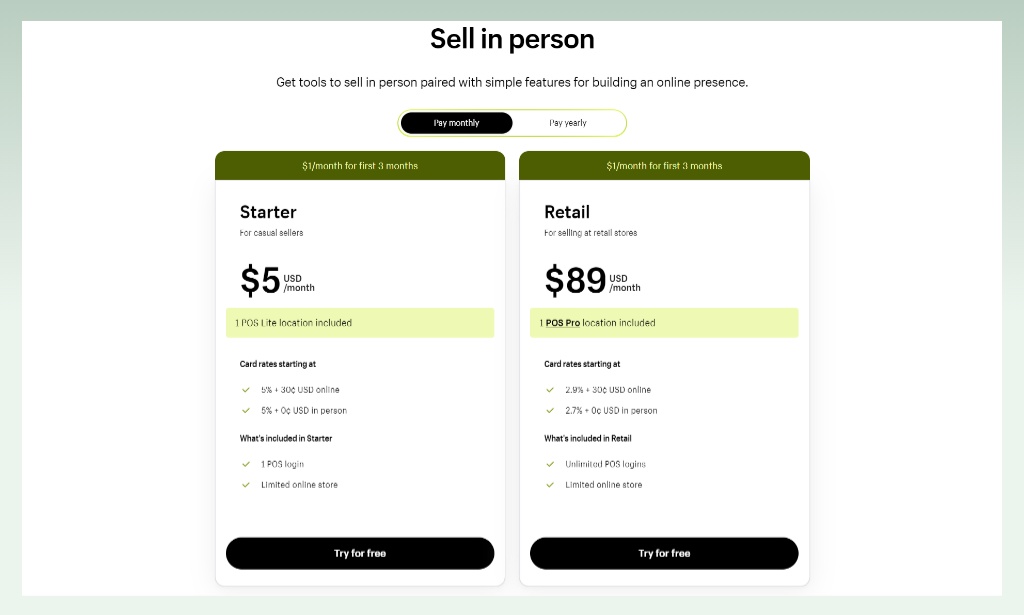
2.1.2. Lightspeed
Lightspeed offers three primary POS pricing plans for 1 location and 1 cash register* as follows:
- Lean: Priced at $89 per month, tailored for essential business needs.
- Standard: At $149 per month, ideal for omnichannel businesses.
- Advanced: For $269 per month, offering more tools for businesses looking to expand further.
- Enterprise: Custom pricing, recommended for high-volume and large stores.
*If you need to set up a POS system in more than 1 location or set up more cash registers, Lightspeed will charge you extra costs depending on your plan.
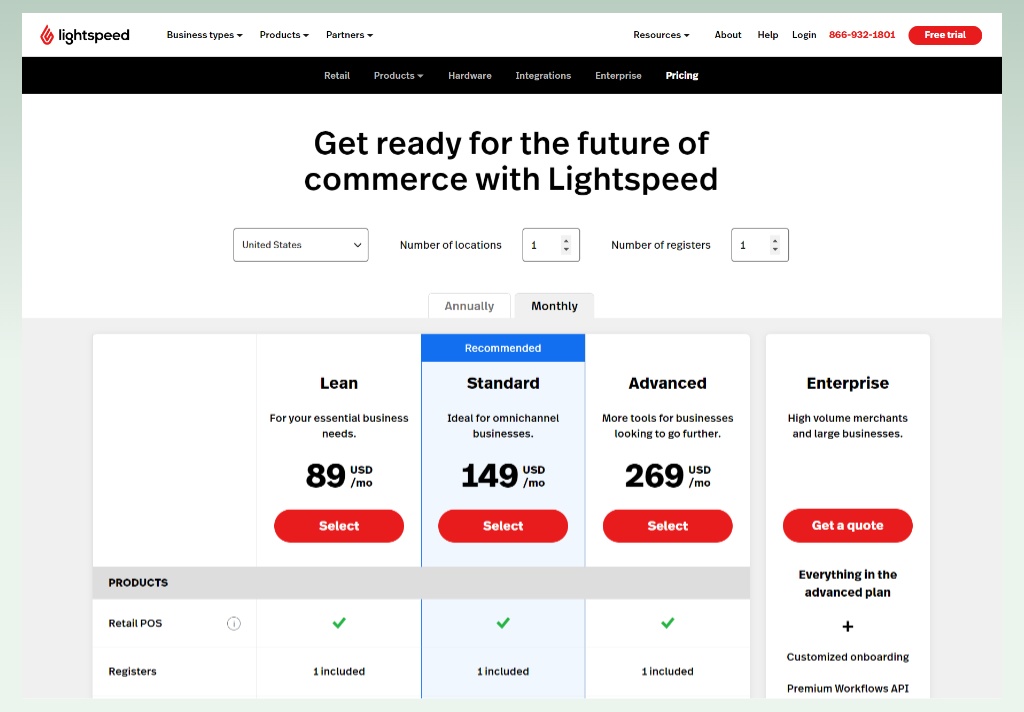
Our verdict: For those on a budget or wanting an integrated online-offline solution, Shopify is a more economical choice.
2.2. Ease of use
You wouldn’t want to spend hours after hours navigating around a platform just to get some basic tasks done. Hence, ease of use would be the next aspect we’ll examine in this Shopify vs Lightspeed POS review.
2.2.1. Shopify
Shopify is well-reputed for its ease of use. The platform’s simplified and intuitive dashboard allows you to effortlessly add products, manage inventory, fulfill orders, accept payments, etc.
In terms of customization, you can leverage Shopify’s drag-and-drop editor to customize your store’s look and feel without coding.

Regarding POS features, Shopify supports syncing your store’s crucial data to the Shopify POS system, including products, customers, orders, and analytics. This means you can manage both your online and physical store smoothly without having to keep track of them separately.
2.2.2. Lightspeed
Meanwhile, Lightspeed’s focus is on detailed management features. This makes the platform suitable for businesses that require a more specialized set of tools and are willing to navigate its slightly more complex interface.
But don’t take us wrong. Though Lightspeed has a slightly steeper learning curve compared to Shopify, the platform is still user-friendly, allowing you to manage a multi-store business without the need for coding.
Our verdict: Shopify is more user-friendly. Both platforms are intuitive, but we like Shopify more as the platform lets you manage your omnichannel business with fewer technical hassles.
2.3. Support
No matter how easy to use a platform, you will likely encounter several technical issues when managing your store. In those situations, reaching timely support can be more valuable than anything else.
So, let’s compare the support that Shopify vs Lightspeed offers.
2.3.1. Shopify
From our experience, Shopify’s support is out of this world. They offer 24/7 live chat support with literally immediate responses. Or, if you want, you can also schedule a phone call or reach out to Shopify staff via email.
2.3.2. Lightspeed
Lightspeed, on the other hand, offers more traditional support hours, which can sometimes be limiting. That said, the quality of support they provide is excellent. Their team is thorough and well-informed, often helping us resolve complex issues with great detail.
Our verdict: Shopify wins convincingly for customer services with their 24/7 live chat support.
2.4. Key eCommerce & POS features
Up next, let’s see how Shopify vs Lightspeed compete with each other in eCommerce and POS features.
2.4.1. Shopify
From our experience, Shopify is one of the platforms with the most extensive set of eCommerce features. Here is a list of Shopify’s eCommerce features we are most impressed by:
- Store setup and design: With an intuitive drag-and-drop editor you can easily customize your storefront without the coding part.
- Product management: You can efficiently manage products with variants, inventory tracking, and bulk editing.
- Payment processing: Shopify offers its own payment gateway and supports 100+ third-party options.
- International commerce: The platform’s multi-currency and multi-language capabilities allow you to localize your store for different markets.
- Multi-channel selling: Shopify allows you to sync your products on social media platforms and online marketplaces besides your POS system.
- SEO and marketing tools: You get to choose from 8,000+ apps on the Shopify App Store to extend your store’s functionalities.
In terms of POS features, Shopify provides you with sufficient tools to manage your physical store’s operations. Some notable features include:
- In-store sales: Seamless integration with online store, user-friendly for staff.
- Reporting and analytics: Robust reporting tools suitable for small to medium-sized businesses.
- Multi-location support: Efficiently manages inventory across multiple locations.
2.4.2. Lightspeed
With Lightspeed’s Standard, Advanced and Enterprise, you unlock essential eCommerce features to launch an online store, including:
- Store setup and design: Lightspeed offers customizable templates but has fewer pre-designed themes compared to Shopify.
- Product management: Robust product management, including variants and inventory control.
- Payment processing: Integrates with various payment processors for flexibility.
- SEO and marketing tools: Provides SEO optimization and integration with over 100 tools.
POS features:
- In-store sales: Advanced features for in-store sales, including customizable, automatic discounts and employee management.
- Reporting and analytics: Advanced analytics and reporting suitable for larger retailers. For instance, you can access sales trends for each location.
- Multi-location support: Effective multi-location inventory management.
- Industry-specific focus: Lightspeed offers a restaurant-specific version of its POS system, which includes table management, menu customization, and kitchen-to-waitstaff communication tools, features that Shopify’s general POS system does not focus on.
- Detailed customer management: With Lightspeed’s POS system, you can add customizable fields like birthdays or any special notes.
- Accepting offline transactions: Unlike Shopify, Lightspeed POS system doesn’t net wifi connection to work.
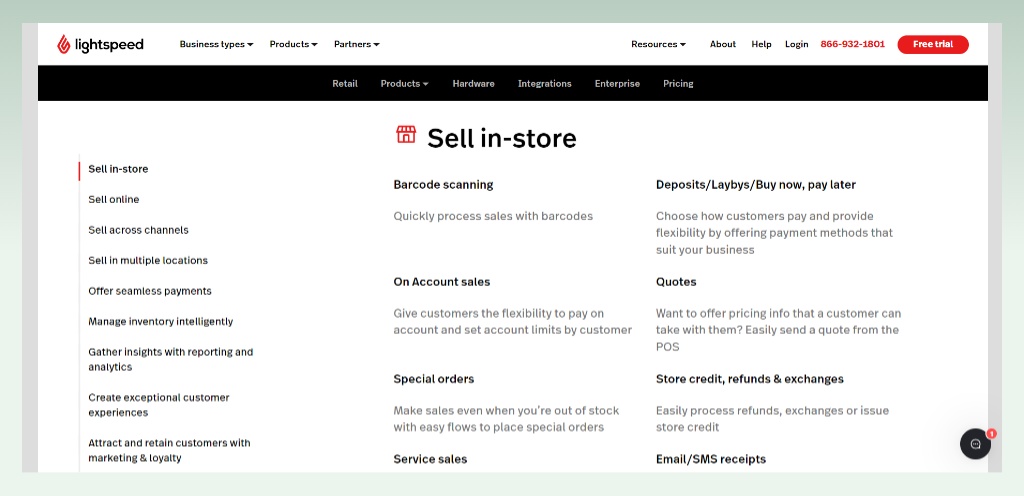
Our verdict: It’s really a tie right here. When it comes to eCommerce features, Lightspeed apparently cannot even come close to the features Shopify offers. However, in terms of advanced POS features, Lightspeed is a much better choice.
2.5. Location management
If you have more than one physical store or need robust features to manage your operations more efficiently, make sure the platform you choose has pro location management features.
Thus, let’s see how Shopify vs Lightspeed performs in this aspect.
2.5.1. Shopify
Shopify provides a streamlined approach to managing POS across multiple locations, emphasizing ease and efficiency. Its system is designed to cater to businesses looking for straightforward solutions without sacrificing functionality.
Here are some notable location management supported by Shopify:
- Track and manage inventory across all your store locations in real-time
- Access combined sales, inventory, and customer data from all locations in one dashboard
- Adding new locations is intuitive, requiring minimal technical know-how
- Shopify’s POS supports a wide array of payment methods, facilitating seamless transactions across different locations
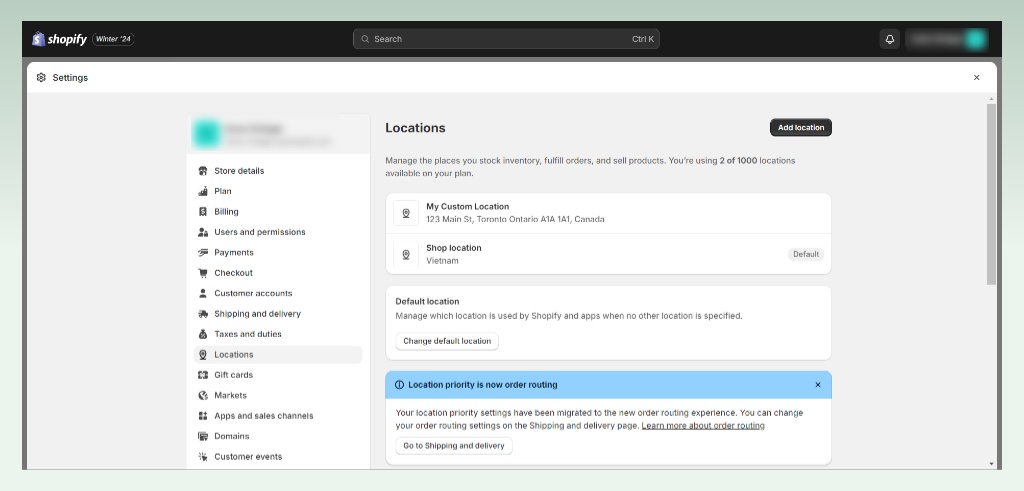
2.5.2. Lightspeed
Lightspeed takes a more granular approach to POS location management, offering you detailed features that cater to businesses with complex needs, such as those in retail and hospitality. This includes:
- Provides detailed tracking capabilities, including variant-level management.
- The ability to customize the POS interface to fit the specific needs of different locations
- Comprehensive reports on sales, inventory, and customer preferences by location
- Specialized functionalities, such as table management for restaurants and appointment scheduling for services

Our verdict: Lightspeed is more suitable for businesses with complex multi-location setups and intricate inventory requirements.
2.6. Inventory management
2.6.1. Shopify
Shopify comes with robust inventory management features, including:
- Manage stock levels across all sales channels from a single dashboard, offering a cohesive view of product availability.
- Easily import or update products in bulk through CSV files
- Automatically adjusts inventory levels when sales are made, returns are processed, or stock is added
- Supports multiple variants (like size, color, etc.), allowing for detailed inventory tracking down to the variant level.
- View changes in your inventory over time, helping identify trends or pinpoint issues.

2.6.2. Lightspeed
Lightspeed goes a step further, offering features that cater to businesses with more complex inventory needs, such as those in retail, hospitality, or businesses that deal with detailed product categorizations.
Regarding inventory management, Lightspeed offers you the following features:
- Granular control over inventory with detailed categorizations
- Serialized inventory tracking for items with serial numbers
- Manage stock across multiple locations and warehouses, with the ability to transfer inventory and view stock levels by location.
- Create and track purchase orders directly within the system
- Comprehensive reports on stock levels, sales trends, and order history, enabling informed decision-making.
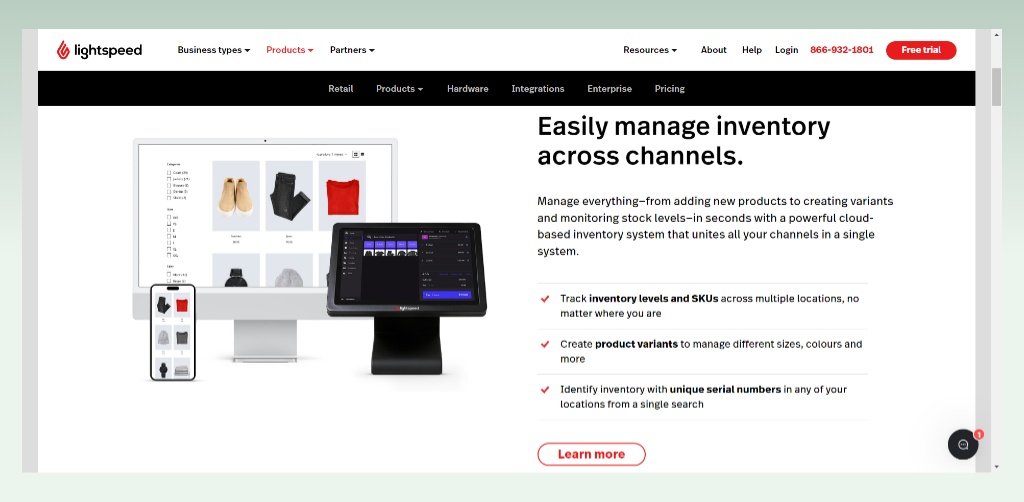
Our verdict: Lightspeed is a superior choice for businesses with complex inventory requirements, demanding features such as deep categorization, kitting tools, waste tracking, work order management, and warranty tracking.
2.7. Customer management
2.7.1. Shopify
With Shopify, you have the capability to build detailed customer profiles, accessible during both online and in-person checkout processes. These comprehensive profiles enable you to keep tabs on crucial information such as contact details, purchase history, and lifetime spending patterns.

Talking of customer management, here is what you expect to get from Shopify:
- Comprehensive data on customers, including their purchase history, contact information, and preferences.
- Direct integration with email marketing platforms like Shopify Email, allowing for targeted campaigns based on customer behavior and purchase history.
- While primarily through third-party apps, Shopify offers a wide range of options for creating custom loyalty and rewards programs
- Robust segmentation tools that allow for detailed marketing strategies, though with a more intuitive approach that can be easily managed by businesses of any size.
2.7.2. Lightspeed
Lightspeed takes a comprehensive approach to customer management, offering in-depth tools and features for stores that require a more detailed understanding of their customer base. Here’s a sneak peek of Lightspeed’s customer management features:
- Provides detailed insights into customer behaviors and preferences, with the capability to track more nuanced data, such as visit frequency and average spending.
- Features an integrated loyalty program that’s more seamlessly connected to the customer’s purchasing history, enabling rewards and promotions that are automatically applied.
- Includes more flexible tools for personalized communication, such as email marketing and SMS, with the ability to tailor messages based on detailed customer data.
- Offers comprehensive reporting tools that not only cover sales but also give insights into customer engagement and loyalty program effectiveness, allowing for data-driven decision-making.
Our verdict: Lightspeed defeats Shopify with its built-in loyalty features and detailed customer analytics.
Shopify’s customer management features are great, but to extend it to Lightspeed’s level, you’ll need to invest in extra third-party apps or a customer relationship management (CRM) system CRM.
2.8. POS hardware
Last but not least, let’s check out the diversity and quality of POS hardware of Shopify vs Lightspeed.
2.8.1. Shopify

Shopify’s POS hardware is designed with an emphasis on aesthetics and ease of use, ideal for small to medium-sized businesses that value simplicity and efficiency. The key components include:
- Compact card readers: Sleek design, facilitating quick, secure payments with a tap, dip, or swipe.
- Stylish iPad stands: Transforms an iPad into an elegant sales terminal, enhancing the customer checkout experience.
- All-in-one retail kit: Includes a receipt printer, cash drawer, and barcode scanner that integrate seamlessly with the Shopify POS app, offering a streamlined setup process. The hardware is notably user-friendly, making it easy for staff to learn and use.
2.8.2. Lightspeed
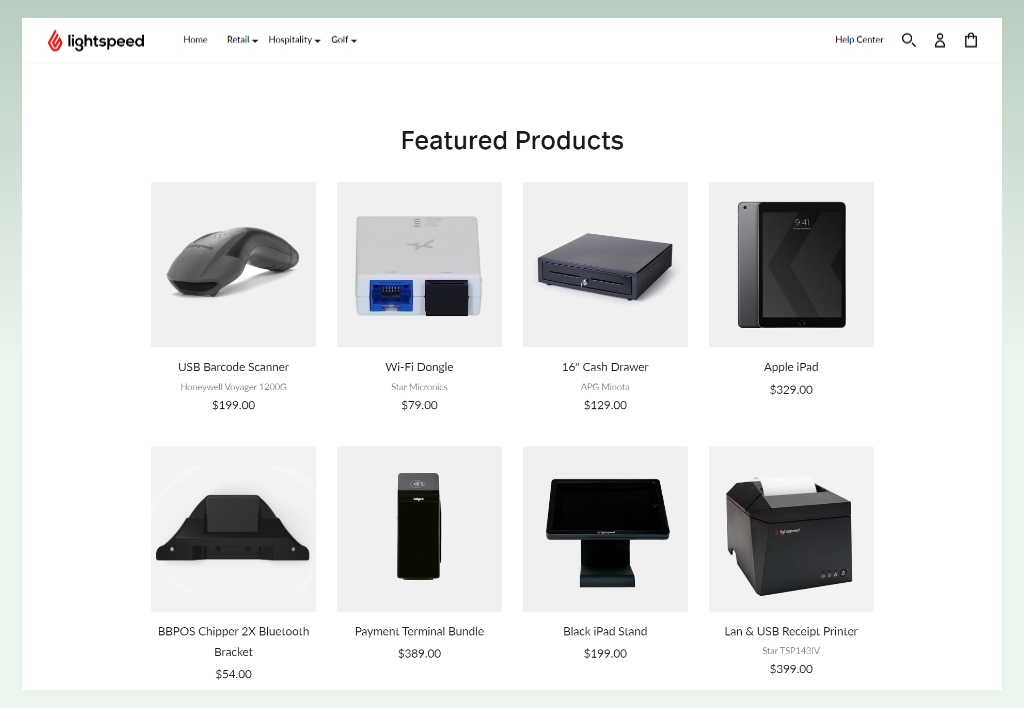
Lightspeed’s POS hardware offers robustness and versatility, aimed at businesses with more complex needs like restaurants, cafes, and retailers with extensive inventories. Highlights include:
- Durable tablets and touch screens: Built to withstand high-volume usage, these devices cater to fast-paced environments.
- Specialized kitchen printers: Essential for restaurants, they allow for clear, efficient order communication to the kitchen, improving service speed and accuracy.
- Industry-specific barcode scanners: Engineered for quick scanning of diverse products, these scanners support retailers in maintaining accurate inventory levels.
Our verdict: Lightspeed wins with its durable, customizable hardware that can handle higher volumes or specialized tasks.
3. Our final…of final verdict of Shopify vs Lightspeed
It’s recap time! Let us help you wrap things up with a scannable table summarizing all Shopify vs Lightspeed pros and cons, as well as who we recommend the platform for!
 |  | |
| Pros | + User-friendly interfaceRobust eCommerce features + Over 8,000 apps to extend your store’s functionalities + Sleek and stylish POS hardware + Easy setup and operation | + Robust and versatile POS hardware Advanced inventory management features + Specialized solutions for restaurants and complex retail + In-depth reporting and analytics |
| Cons | – May lack advanced features for specialized businesses – Limited customization options for POS | – Limited built-in eCommerce features – Not many integrations to work with |
| Suitable for Businesses | Online-oriented stores who want to seamlessly and smoothly manage their newly-established physical store. | Offline-oriented businesses require customized POS solutions for specific operational needs. |
4. The bottom line
Have you got the answer to which platform to pick between Shopify vs Lightspeed? Well, we bet you’ve figured out the answer by now. 😉
If you are into eCommerce platform comparison articles like this, explore our unbiased eCommerce comparison topics for more relevant insights.
Also, check out eComStart.io to get yourself updated with all things eCommerce.


